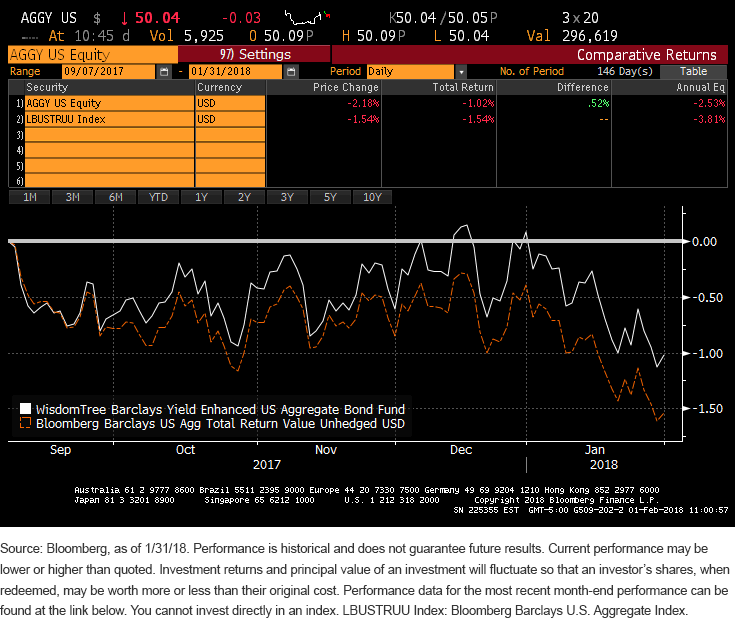Fixed Income: Weathering the Storm


One of the more noteworthy developments during the first month of the new year was the steady sell-off in the U.S. Treasury (UST) market. While the headlines have tended to focus on January 2018 developments, the rise in rates has actually been occurring for an even longer period. For fixed income investors, the key question is: How has my core position weathered the storm of higher rates?
I’ve written extensively about the Fed’s role in pushing short-term rates higher, but this time around, the whole yield curve has experienced an elevated trend. Going back to my earlier point, the increase in rates actually goes back to September 7 of last year when the UST 10-Year yield printed its most recent low watermark of 2.04%. Since then, as of this writing, the yield has risen 67 basis points (bps) through the end of January, revisiting levels not witnessed since 2014.

Click here for AGGY standardized performance.
For many fixed income investors, their core fixed income strategy focuses on the Bloomberg Barclays U.S. Aggregate Index, or the Agg. However, as discussed in our July 19, 2017, blog post “Fixed Income Smart Beta: An Evolutionary Tale”, WisdomTree sought to address the counterintuitive features of market cap-based indexing and applied a rules-based approach to core fixed income, where we reweighted the sectors of the Agg. The result was the Bloomberg Barclays U.S. Aggregate Enhanced Yield Index, which is over-weight in investment-grade credit and under-weight in Treasuries. By reducing the market cap-based allocation to Treasuries, this index can potentially help to mitigate the elevated interest rate risk that Treasuries may experience.
The current back-up in UST yields offered a “real-time” illustration to see how these two different approaches to core investing performed. When interest rates rise, as we have seen since early September, it is difficult for core fixed income investments to avoid a negative outcome of some sort, with the goal being that one can keep losses to a minimum. As the chart shows, the WisdomTree Barclays Yield Enhanced U.S. Aggregate Bond Fund (AGGY), which is designed to track the Bloomberg Barclays U.S. Aggregate Enhanced Yield Index, has outperformed the Agg by 52 bps during the period under review, keeping the negative return at a modest -1.02% versus -1.54% for the Agg.
Conclusion
The debate on where the UST 10-Year yield is going for the remaining 11 months of 2018 will no doubt continue. There are many forces to consider, such as global central bank policies, increased Treasury supply and potential geopolitical developments to name a few. However, at some point, it would seem the fundamentals—the economy and inflation outlook—will move front and center, and more than likely be a key arbiter as to whether this latest rise in the UST 10-Year yield has more room to run or whether investors view the higher rate level as a renewed buying opportunity. Either way, we believe investors should utilize a core fixed income strategy that can weather various outcomes and consider AGGY to fill this need.
Unless otherwise noted, data source is Bloomberg as of January 31, 2018.
Important Risks Related to this Article
There are risks associated with investing, including possible loss of principal. Fixed income investments are subject to interest rate risk; their value will normally decline as interest rates rise. Fixed income investments are also subject to credit risk, the risk that the issuer of a bond will fail to pay interest and principal in a timely manner or that negative perceptions of the issuer’s ability to make such payments will cause the price of that bond to decline. Investing in mortgage- and asset-backed securities involves interest rate, credit, valuation, extension and liquidity risks and the risk that payments on the underlying assets are delayed, prepaid, subordinated or defaulted on. Due to the investment strategy of the Fund, it may make higher capital gain distributions than other ETFs. Please read the Fund’s prospectus for specific details regarding the Fund’s risk profile.


